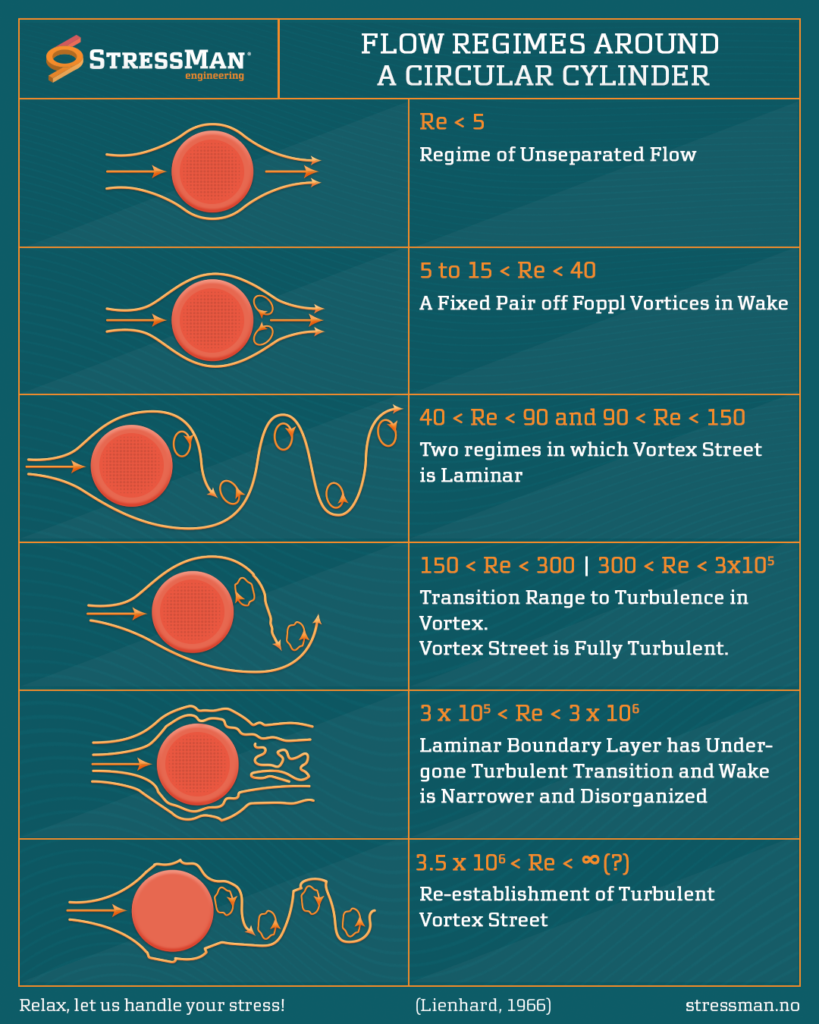Ever wondered how fluid flow interacts with objects like chimneys, bridges, or even power lines? The seemingly simple flow over a circular cylinder is a captivating example in fluid mechanics, with crucial applications across various engineering fields!
By understanding how this flow changes with the Reynolds number (Re), a dimensionless ratio of inertial and viscous forces, we can predict important phenomena. This knowledge helps engineers design structures that are efficient in heat transfer, minimize vibration risks, and even prevent the “singing” of wires in strong winds.
This post delves into the fascinating transition of flow regimes as Re increases:
- Very Low Re (~5): Imagine a gentle breeze. Here, the flow smoothly separates and reattaches around the cylinder, with minimal disruption.
- Low Re (5-40): As the flow velocity picks up (think light breeze), steady, symmetrical eddies form in the wake behind the cylinder, growing in size with increasing Re.
- Moderate Re (40-90): The flow becomes more dynamic. The wake starts to oscillate, and vortices begin to shed asymmetrically, marking the onset of periodicity.
- Higher Re (Above 90): Buckle up! This is where the iconic Kármán vortex street appears (interestingly enough, although named after him, von Kármán wrote himself, the phenomenon was observed by Mallock and Bénard, and has been studied by Prandtl’s doctoral candidate, Karl Hiemenz). A staggered row of alternating vortices forms behind the cylinder, a testament to the fascinating interplay of fluid dynamics.
The Kármán vortex street plays a vital role – it contributes to drag, vibration, and noise generation around objects. Understanding its formation and behavior is crucial in various engineering applications:
- Heat Exchangers: Optimizing heat transfer efficiency in cross-flow heat exchangers used in power plants and refrigeration systems relies on knowledge of flow patterns.
- Structural Engineering: Predicting vortex shedding frequencies helps design chimneys, bridges and other structures to avoid resonance and potential damage from wind-induced vibrations.
- Underwater Pipelines: Understanding drag forces on pipelines allows engineers to design sturdier structures that can withstand underwater currents.
Numerical analysis emerges as a powerful tool for studying these complex flow phenomena. By simulating flow behavior at various Re values, engineers can optimize the design and performance of structures and systems interacting with fluids.
Fun fact: as von Kármán states in his “Aerodynamics”, vortex shedding phenomenon was depicted as early as 14th century in a fresco of St. Christopher carrying Jesus which is found in Bologna. Although the exact location of the artwork is still under discussion (most likely it is found in the church of San Domenico or San Stefano), Bologna is certainly a place worth visiting.

